Acquiring Literacy in English:
Crosslinguistic, Intralinguistic, and Developmental Factors
Test of Phonological Processing in Spanish (TOPPS)
Authors and Date
David Francis, University of Houston; Maria Carlo, University of Miami.; and Diane August, Dorry Kenyon, Valerie Malabonga, Silvia Caglarcan, and Mohammed Louguit, Center for Applied Linguistics. 2001.
Purpose
The Test of Phonological Processing in Spanish (TOPPS) was developed to assess the components of phonological awareness in native-Spanish-speaking children. The test was developed for the research study Transfer of Reading Skills in Bilingual Children, subproject 2 of Acquiring Literacy in English: Crosslinguistic, Intralinguistic, and Developmental Factors.
Age or Grade of Examinees
The assessment was developed to be used with students from kindergarten age through adult.
Description
The TOPPS consists of 9 subtests.
1. Sound Matching: Children identify the word that has the same first or last sound as the prompt word.
Examples:
Test |
Child Sees |
Tester Asks |
Target |
First sound |
pictures of piano (prompt), hourglass, field, feet (choices) |
¿Qué palabra empieza con el sonido /p/ como piano? |
pies |
Last sound |
pictures of honey (prompt), salt, calendar, bread (choices) |
¿Qué palabra termina con el sonido /l/ como miel? |
sal |
2. Rapid Letter Naming: Children see a letter and provide its name.
Examples:
Child Sees |
Target |
o |
/o/ |
t |
/te/ |
u |
/u/ |
3. Blending Words
4. Blending Nonwords
In these two subtests, children combine sounds into a real or invented word.
Examples:
Test |
Child Sees |
Target |
Blending words |
pié-sas |
piezas |
Blending nonwords |
mo-tár |
motar |
5. Elision: Children say what is left of a word after dropping certain sounds.
Example:
Researcher Question |
Target |
“Di tocadiscos. Ahora di tocadiscos sin decir discos.” |
toca |
6. Memory for Digits: Children repeat a series of numbers.
Examples:
Child Sees |
Target |
16 |
dieciséis |
72 |
setenta y dos |
836 |
ochocientos treinta y seis |
7. Segmenting Words
8. Segmenting Nonwords
In these two subtests, children separate the sounds in a word or a nonword.
Examples:
Test |
Child Sees |
Target |
Segmenting words |
mi |
m-i |
Segmenting nonwords |
pa |
p-a |
9. Nonword Repetition: Children repeat nonwords.
Example:
Child Sees |
Target |
vípodre |
bípodre |
Administration
The test is individually administered by a trained native Spanish speaker. The assessment takes approximately 40-45 minutes to administer.
Scoring and Interpretation
The test is scored dichotomously, “1” for Correct and “0” for Incorrect.
Reliability and Validity
Rasch analysis yielded a reliability coefficient of .83 (N=100) for the entire test. Validation data are pending.
Source
The TOPPS was developed as the Spanish version of the Comprehensive Test of Phonological Processing (CTOPP), a standardized test of English phonological awareness that was originally developed by Wagner, Torgesen, and Rashotte.
Wagner, R. K., Torgesen, J. K., & Rashotte, C. A. (1999). CTOPP: Comprehensive test of phonological processing. Austin, TX: Pro-Ed.
Availability
The TOPPS is available from the Center for Applied Linguistics. To request a copy, complete and submit the Application Form for Use of ALE Researcher-developed Assessment Instruments, available in Microsoft Word and Adobe PDF format.
Citation
Researchers using the Test of Phonological Processing in Spanish should cite it as follows:
Francis, D., Carlo, M., August, D., Kenyon, D., Malabonga, V., Caglarcan, S., & Louguit, M. (2001). Test of Phonological Processing in Spanish. Washington, DC: Center for Applied Linguistics.

